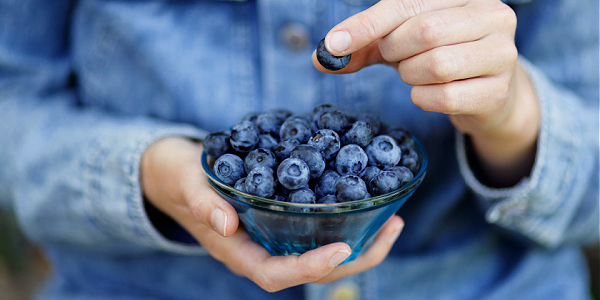
How do you know what you should be eating every day, based on science, to promote your health? The Dietary Guidelines for Americans aim to do just that. It provides science-based advice on what to eat and drink to promote health, help reduce the risk of chronic disease, and meet nutrient needs.
Unfortunately, while thorough, the 164-page document can be somewhat not so user-friendly. Luckily, you can follow this advice in a digestible and practical way by following the MyPlate recommendations.
If you have heard about MyPlate but wonder what it really entails, dive into this breakdown of what MyPlate is and practical recommendations for easily fitting it into your life.
What Is MyPlate?
For the most part, the USDA's Food Guide Pyramid has been used as an educational tool for decades. Teachers and health professionals alike used this model to get adults and children to eat healthier foods.
For others, though, the pyramid itself was too difficult to read. This caused people to feel bewildered and baffled by the differences between healthy and unhealthy foods.
In light of decades of confusion, the USDA released a new model that hopes to put an end to the confusion between what to eat, and what not to eat.
The new model, following USDA nutrition guidelines, is a plate composed of four different portions. The new plate model, appropriately named MyPlate, is a simplified version of the former pyramid. It represents how meals should look to get the recommended amount of foods and nutrients every day.
MyPlate Food Groups and Portions
The plate features individual colored sections, representing your daily recommended portion of a certain food group.
• Purple represents protein - It is recommended to get a variety of protein foods including plant and animal-based.
• Orange represents whole grains - MyPlate suggests at least half of grain foods should be from whole grains.
• Green symbolizes vegetables - Get a variety of different colored vegetables instead of always eating the same ones.
• Red represents fruits - While 100% fruit juice is considered a fruit serving, it is recommended to get most of the fruit from whole fruits over juice.
• Blue represents dairy - Choose low or non-fat dairy options most of the time. If unable or choosing not to eat dairy, choose fortified non-dairy options like soy milk.
These five foods on the plate are meant to be represented at all meals. The MyPlate does not specify quantities at first glance, so it is best to refer to the MyPlate website for food-specific recommendations based on age and gender.
For example, MyPlate suggests that women aged 31 years and older get 2-3 cups of vegetables per day, and men aged 31-59 years get 3 to 4 cups of vegetables per day. This recommended amount for each food group should be spread out during the day with meals and snacks.
If looking for more direction, the MyPlate Plan takes the MyPlate recommendations a step further by giving guidance on what and how much to eat within your calorie allowance based on age, gender, height, weight, and physical activity.
5 Ways to Practically Use the MyPlate Recommendations
The goal of MyPlate is to focus on how meals should look in order to promote health instead of counting servings of food groups throughout the day. These dietitian-approved tips help make following the MyPlate easy.
1. Half Your Plate with Fruits and Veggies
Probably the hardest part about following MyPlate recommendations is making your plate half filled with fruits and vegetables, as most Americans do not get the recommended servings.
Instead of planning meals only around protein, focus on what fruits and vegetables you can add as well. Make them the star just as much as the protein.
Breakfasts can be especially hard for getting a fruit and vegetable in. Make it easy to have a MyPlate-inspired breakfast by making a breakfast smoothie based on fruits and vegetables or top whole grain toast with avocado or hummus with sliced cucumbers and tomato.
2. Make Whole Grains the Default Choice
While MyPlate suggests making half of grains a whole grain choice, an easier (and healthier) approach is to simply make whole grains the default choice.
Choose whole grain bread, pasta, rice, tortillas, muffins, cereal, etc. in place of white, sugary, and refined grains.
3. Eat a Variety of Foods
Variety is key to getting all the nutrients to promote health from food. No single food has all the antioxidants, vitamins, and minerals needed throughout the day.
While MyPlate focuses on eating a variety of food groups, also eat various foods within a food group.
4. Don't Forget About Snacks
MyPlate is designed for modeling balanced meals to promote health, but snacks should not be overlooked. If meals follow the MyPlate plan, but snacks are full of refined, and high sugar choices, health can negatively be affected.
Choose snacks that are based on the MyPlate approach, as doing so can help you stay on track with healthy eating. Snacks can also help fill in nutrient gaps at mealtimes and reach recommended servings of foods, especially fruits and vegetables.
5. Incorporate Dairy Alternatives as Needed
A serving of dairy is recommended at all meal times according to MyPlate. However, for those who are vegan, lactose intolerant, or simply want to cut back on dairy, it is important to eat and drink dairy alternatives that provide a source of protein, calcium, and vitamin D.
It may be surprising to know there are many dairy-free calcium sources beyond dairy!
MyPlate Bottom Line
The MyPlate is designed to give a recommendation of how meals should look in order to eat the right types and amounts of foods that promote health. It is considered by most to be a more user-friendly and practical guideline compared to the earlier Food Guide Pyramid.
Following the MyPlate means half your plate should be fruits and vegetables at meals, which may be arguably the hardest part. Grains and proteins make up the rest of the plate with the focus being on choosing whole grains more often and a variety of proteins.
A serving of dairy is also recommended at all meals and may need to be substituted for non-dairy sources that still provide a source of protein and bone-building nutrients for those who need or want to limit dairy.
References:
Are you making every bite count? MyPlate. https://www.myplate.gov/.
Dietary guidelines. NAL. https://www.nal.usda.gov/legacy/fnic/dietary-guidelines.







